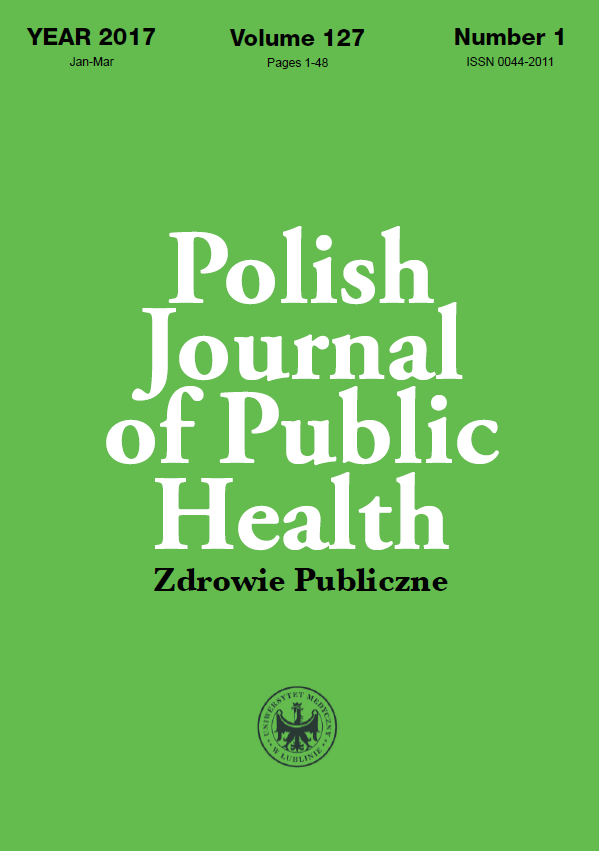Comparison of two treatment methods of congenital clubfoot in the orthopaedists’ opinion
DOI:
https://doi.org/10.1515/pjph-2017-0007Keywords:
congenital talipes equinovarus, clubfoot, lower limb defect, foot deformity, Ponseti method, Turco methodAbstract
Introduction. Clubfoot is the second most common birth defect of the lower limb. In Europe (including Poland) it concerns about 1-2 in 1000 newborns. What is characteristic for a clubfoot, is change in the foot shape and its impairment with preserving anatomical structures.
Aim. The aim of this work is to gather opinions of orthopedic physicians on the effectiveness of the two methods used to treat congenital clubfoot: the Turco method and the Ponseti method.
Material and methods. The research method used in the work was a diagnostic survey and research technique was the author’s questionnaire designed to gather opinions of orthopedic surgeons on the two methods of clubfoot treatment. The questionnaires were collected in the Orthopaedic Clinics in Lublin and Rzeszów, as well as during the specialization courses for orthopaedic surgeons in Lublin.
Results. The most important advantages of the Ponseti method according to respondents are high clinical effectiveness (average 4.48) and short duration of hospitalization (average 4.31). While the most important disadvantages of the method is length of rehabilitation (average 2.85) and convalescence (average 2.36). Top assets of the Turco method in turn, according to respondents, are high clinical efficiency (average 2.92) and certainty of the patient’s recovery (2.74). In turn, the downsides of the Turco method according to the respondents are high invasiveness (average 4.11) and length of convalescence (average 3.87).
Conclusion. The Ponseti method is the surveyed doctors’ preferred method of congenital clubfoot treatment.
References
1. Lykissas MG, Crawford AH, Eismann EA, Tamai J. Ponseti method compared with soft-tissue release for the management of clubfoot: A metaanalysis study. World J Orthop. 2013;18,4(3):144-53.
2. Handelsman JE, Badalamente MA. Neuromuscular studies in clubfoot. J Pediatr Orthop. 1981;1:23-32. [Crossref]
3. Ostrowski J, Karski T, Okoński M. Zmiany kształtu i ustawienia kości skokowej u osób operowanych w dzieciństwie z powodu wrodzonych stop końsko-szpotawych. Chir Narz Ruchu Ortop Pol. 1996;61(Suppl. 3A):261-5.
4. Karski T. Wośko I. Experience In the conservative treatment of congenital clubfoot In newborns and infants. J. Pediatr Orthop. 1989;9:134-6.
5. Karski T, Ostrowski J, Tarczyńska M, et al. Wyniki leczenia operacyjnego wrodzonych stop końsko-szpotawych techniką Turco i Goldnera z modyfikacją własną. Kwart Ortop. 2001;2:120-4.
6. Fujak A, Forst R, Forst J. Outcome after Achilles ten don lengthening with a posteriori capsulosis according to imhauser In idiopathic congenital clubfoot. OTR. 2008;4(6):367-76.
7. Cummings RJ, Davidson RS, Armstrong PF, Lehman WB. Congenital clubfoot. J Bone Joint Surg. 2002;84:290-308. [Crossref]
8. Papavasiliou V, Papavasiliou A. A novel surgical option for the operative treatment of clubfoot. Acta Orthop Belg. 2004;70:155-61.
9. Turco VJ. Surgical correction of the resistant clubfoot. One stage posteromedial release with internal fixation : a preliminary report. J Bone Joint Surg. 1971;53-A:477-97. [Crossref]
10. Karski T, Tarczyńska M, Ostrowski J, et al. Leczenie operacyjne wrodzonej stopy końsko-szpotawej techniką uwolnienia tylno-przyśrodkowego – odniesienie do metody Turco na podstawie własnych obserwacji. Chir Narz Ruchu Ortop Pol. 2001;66(3):275-84.
11. Turco VJ. Surgical correction of the resistant club foot. J Bone Joint Surg. 1971;53A(3):477-97. [Crossref]
12. Hussain S, Khan MS, Ali MA. Modified Turco’s postero-medial release for congenital talipesequino-varus. J Ayub Med Coll Abbottabad. 2008;20(3):78-80.
13. Siddiqui M, Pirwani M, Bhura S. Window procedure versus Turco procedure for the treatment of talipes equinovarus. Pakistan J Surg. 2007;23(3):212-6.
Downloads
Published
Issue
Section
License
Copyright (c) 2017 Polish Journal of Public Health

This work is licensed under a Creative Commons Attribution-NonCommercial-NoDerivatives 3.0 Unported License.


